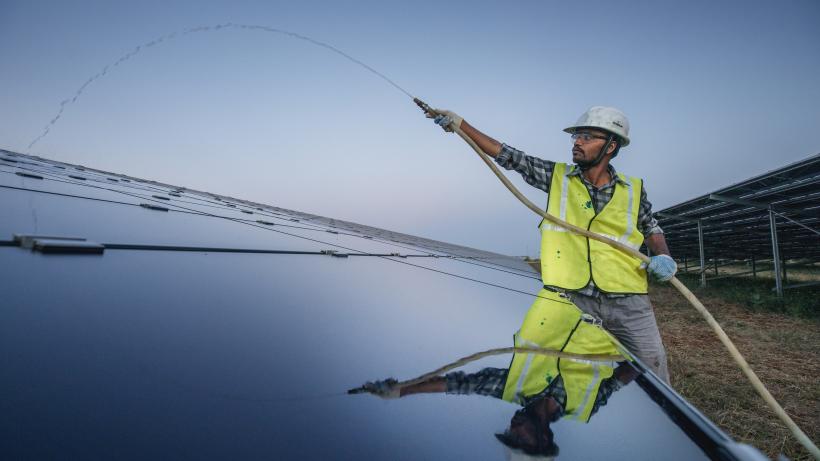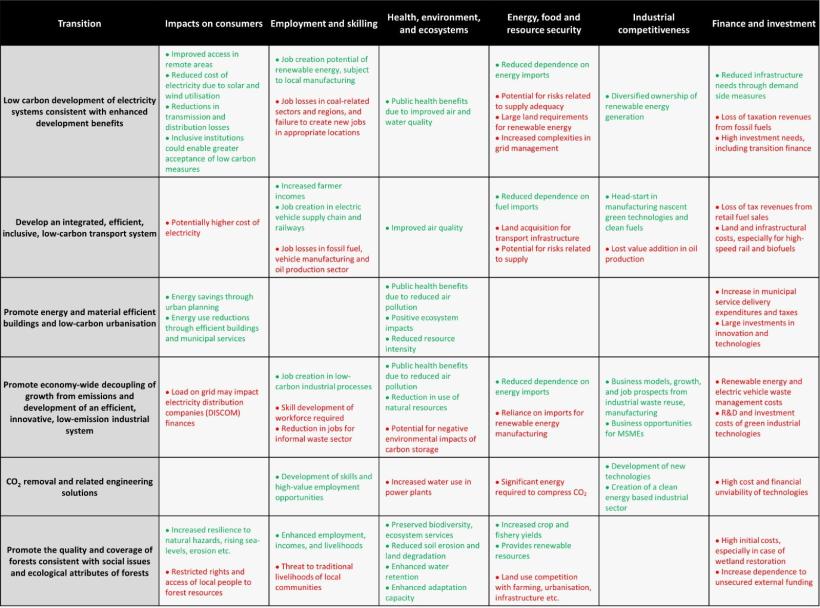
Keeping development at the forefront of India’s long-term climate strategy
India’s Long Term Low Emissions Development Strategy (LT-LEDS) sets out multiple low-carbon transitions, and highlights how climate action will be intimately tied to development. To operationalise the LT-LEDS effectively, India will benefit from planning now to minimise the trade-offs between low-carbon futures and development.
India is now well into its yearlong G20 Presidency, during which it has committed to advance global cooperation on challenges such as international security, trade, finance, and crucially accelerating transformative climate action. Across the world, climate change is expected to adversely impact progress towards poverty eradication and human development. As a rapidly growing, climate-vulnerable economy, it is in India’s best interests to foster global climate cooperation, and encourage informed action on low-carbon development pathways at home.
This is no easy task. Since climate and development challenges are deeply intertwined, India’s emissions will be driven by structural economic choices about how it urbanises and industrialises just as much, if not more than, by emissions-focussed policies and decisions (Spencer and Dubash 2021, Schipper et al. 2022). As a result, Indian policymakers have multiple development objectives to contend with – energy security, industrial competitiveness, job creation, and economic growth, among others – and climate considerations will intersect with these objectives in different ways (Bhardwaj et al. 2019). Any meaningful engagement with climate policymaking in India, therefore, requires an assessment of its development costs, opportunities, and risks for other sectors of the economy.
At the United Nations Climate Change Conference 2022 (or COP27), India released a long-term strategy document that lays down a roadmap for decarbonisation against the backdrop of these considerations. India’s long-term low-emission development strategy (LT-LEDS) is notable for two reasons. First, it places low-carbon development at the centre of its strategy rather than adopting a pure emissions focus. This approach prioritises India’s social and economic objectives, while also recognising that locking in on a high-carbon growth pathway is no longer a feasible option for people or the planet. Second, the LT-LEDS envisions achieving low-carbon development through seven ‘strategic transitions’ – that is, profound socioeconomic and technical shifts, relating to (i) electricity, (ii) transport, (iii) urban planning and buildings, (iv) industry, (v) carbon dioxide removal, (vi) forests, and (vii) climate finance. These transitions, which cut across ministries and sectors, form the core elements of India’s mitigation strategy.
The carefully crafted framing of these transitions sets the stage for a deeper dive into the interlinkages between climate and development. Operationalising the low-carbon development approach requires thinking about synergies and trade-offs between the two. In this article, we initiate this conversation by expanding on the developmental opportunities and challenges of low-carbon transitions that are discussed in India’s LT-LEDS (shown in Table 1). We cluster the opportunities and challenges around six developmental and socioeconomic considerations (listed in Table 1 as column heads), which we infer based on the content of India’s LT-LEDS. In exploring the developmental opportunities and challenges embedded within India’s strategy, we hope to illustrate how these low-carbon transitions might interact closely with the economic and social sectors with which they are most directly involved.
Table 1: Development opportunities (in green) and challenges (in red) associated with India’s envisioned low-emission development transitions

Two caveats relating to Table 1 are worth mentioning. First, the opportunities and challenges that we highlight pertain to public sector actions and responsibilities. For example, in the case of low-carbon urbanisation, ‘increased municipal service expenditure’ and ‘higher investments in innovation and technology’ are both framed as financial challenges, even though these are likely to result in better outcomes for urban dwellers. The reason for this framing is to highlight that Indian policymakers have multiple considerations aside from reducing emissions – including minimising policy costs and allocating scarce public finance to different policy priorities – and that the interplay of these multiple objectives influences climate strategy-setting.
Second, the opportunities and challenges highlighted in this table are based on the prevailing political economy at the time when the LT-LEDS was prepared. These are likely to evolve. More opportunities and challenges may surface over time as national and global realities and priorities change, and as our understanding of the developmental implications of low-carbon transitions deepens. Thus, though the classification of individual entries as opportunities and challenges remains static over time, the mix of entries within a particular cell and their relative salience may shift.
Below, we elaborate on four of the developmental considerations in Table 1: employment and skilling; finance and public spending; energy and food security; and impacts on consumers. We focus on these four because they each represent a nuanced combination of both challenges and opportunities.
Shifts in employment patterns
Generating employment is one of India’s principal priorities; for instance, a McKinsey report estimates that India needs 90 million new non-farm jobs by 2030 (Sankhe et al. 2020). A development pathway reliant on low-carbon technologies offers potential for generating employment in nascent sectors such as India’s Green Hydrogen Mission, which aims to create 600,000 jobs by 2030.
At the same time, the phase-down of fossil fuel-intensive sectors also risks worsening unemployment. The coal industry employs about 1.2 million people, and indirectly supports 13 million jobs in allied sectors (Dsouza and Singhal 2021, Mehrotra 2022). The auto components industry employs 5 million people. Such jobs – along with traditional livelihoods of local communities – will be at risk, and they are not directly substitutable by jobs that are created in the low-carbon sectors, which may be located in other geographical regions and are often impermanent in nature, without as many long-term employment prospects.
Given the potential shifts in employment patterns due to the operationalisation of India’s LT-LEDS, and the associated implications on the economy and migration, it is important to manage the impacts of these potential job losses, while continuing to reap greater employment benefits from low-carbon development.
Impacts on finance and public spending
A low-carbon development pathway carries significant implications for finance and public spending. Modelling studies suggest the possibility for future GDP gains, but these are based on the assumption of large upfront investments. Understanding the necessary conditions and scope for financial benefits are an essential element of understanding the implications of low-carbon pathways.
For example, modelling studies estimate a boost to India’s long-term GDP ranging from the hundreds of billions to the trillions (see, for instance, Agarwal et al. (2021), Masterson (2021), and Swamy and Agarwal (2022)). Greater energy security through renewable sources can reduce imports, while exporting low-carbon technologies can also improve India’s trade balance if the transition is carefully managed. There may also be a development dividend associated with renewable energy that can increase rural productivity (Swain 2020).
However, the deployment of these technologies at scale will require large upfront investments, cumulatively adding up to several trillion dollars (Singh and Sidhu 2021, Gupta et al. 2022).1 Such investments will have to be supported by significant public expenditure. At the same time, central and state public revenues may also shrink – 25% and 13% respectively currently come from fossil fuel taxes (Gambhir et al. 2021). Together, these can adversely impact the government’s ability to continue supporting India’s development priorities.
There are indications of growing willingness to allocate funds for a green transition: the government recently approved a multi-year outlay of INR 197 billion for the Green Hydrogen Mission, and allocated INR 350 billion to energy security objectives in the 2023-24 budget, although the exact use of the latter funds was not specified. Continuing and expanding such investments will require carefully managing public revenues and efficiently mobilising the private financial sector.
Ensuring energy and food security
India is currently dependent on imported oil and gas (and some coal) to meet its growing energy needs. In addition to the security implications of depending on a foreign nation for energy supply, this import dependence is a drain on India’s coffers. Energy imports also affect India’s currency, as global energy markets are dollar-denominated. The low-carbon transition can reduce the magnitude of this dependence. For instance, achieving 20% ethanol blending in petrol could help save approximately INR 300 billion worth of foreign exchange annually (NITI Aayog, 2021). However, the transition could result in substituting one form of import dependence with another if India were to import most of its green energy.
In addition, a low-carbon transition would likely increase pressures on land – for producing biofuels, solar parks, expanding forest areas, among others, which could cascade in the form of increased food insecurity.
Ensuring India’s energy security will require a serious public debate about the choice of low-carbon development pathway (for example, the share of private cars compared to public transportation) implied within the LT-LEDS, as well as adequate R&D investments in green value chains.
Impacts on consumers
Consumers of electricity and fuels are likely to be beneficiaries of the low-carbon transition. The proliferation of distributed electricity resources, such as electric vehicles that feed electricity back into the grid, could help increase the resilience of the grid. Further, the long-term price of electricity is expected to fall, reducing household electricity bills and increasing the competitiveness of India’s manufacturers. Reducing India’s dependence on oil could also protect consumers against inflationary effects and volatility associated with fuel prices. Consumers will also be able to generate their own ‘captive’ electricity instead of being dependent on grid supply, which remains unreliable in several remote areas (Jadhav 2021).
On the flip side, enabling commercial and industrial (C&I) consumers to ‘leave’ the grid can adversely affect other consumers by destabilising the financial model of electricity distribution companies, which overcharge C&I consumers to cross-subsidise agricultural consumers. This raises fundamental questions about whether electricity will continue to be conceptualised as a welfare good rather than a commodity (Dubash et al. 2019); in case it is the latter, the poorest consumers risk significantly reducing their consumption of electricity or losing access altogether, which would have cascading effects on their quality of life.
Explicitly signalling the need to strengthen consumer rights, expand consumer participation in decision-making processes and create opportunities for community ownership of energy production may be key issues for the transition to be truly consumer centric. Similarly, a debate on making public investments and subsidies more equitable is also required – for instance, subsidies for passenger EVs could disproportionately benefit the rich (Linn 2022).
Conclusion
India is seeing simultaneous, large-scale transitions in infrastructural demand, energy consumption, and urbanisation, all of which will shape energy and emissions pathways. India’s LT-LEDS is a strategic document that outlines a long-term low-carbon vision for India while taking into account the interlinkages between climate and development imperatives. These interlinkages are deep and complex, and represent both developmental challenges and opportunities inherent within India’s possible decarbonisation pathways.
As India begins to operationalise its LT-LEDS, it must overcome challenges to its development priorities, while simultaneously capitalising on the opportunities to achieve multiple development objectives. With advance planning and strategy, there may be scope to enhance synergies and minimise the impacts of trade-offs.
It is, thus, important to study these interlinkages more carefully and plan for them appropriately. This can involve multi-objective approaches to policymaking: closer consultations with relevant stakeholders and other public agencies to explore avenues for mainstreaming climate considerations into their respective domains; coordination with financial policy; investments in R&D and manufacturing capabilities; and broader engagement with social sector decision-makers and civil society. The key message from the LT-LEDS is that with adequate foresight and planning, India can anticipate and prepare for the challenges of low-carbon development futures, and proactively seek to maximise potential development gains.
Note: Divergences in estimates are due to different modelling approaches, cost assumptions, and time horizons.
This article was first published in Ideas for India.

